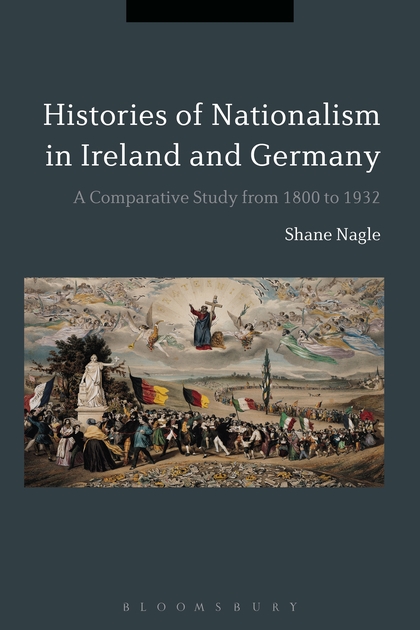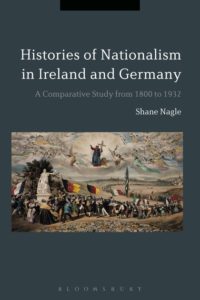
Histories of Nationalism in Ireland and Germany: A Comparative Study from 1800 to 1932 by Shane Nagle
 This is part of our special feature on Nationalism, Nativism, and the Revolt Against Globalization.
This is part of our special feature on Nationalism, Nativism, and the Revolt Against Globalization.
The comparative approach has long been recognized as an effective means of analyzing nationalism, even if studies of nationalist movements remain mostly confined within nation-state frameworks. While the appeal of nationalist rhetoric is rooted in its claim to represent the unique values, aspirations, and destiny of a specific national community, comparative studies emphasize the political and cultural commonalities shared by various brands of nationalism. Shane Nagle’s contribution to this field is particularly insightful due to the originality and sharp focus of his study, which explores the close relationship between nationalism and history.
This lucid study draws on a large body of national historical narratives published in Ireland and Germany between 1800 and 1932. Usefully, Nagle has chosen to compare two nations with very different historical experiences. German unification occurred in 1871, while southern Ireland did not achieve independence until 1922. Irish nationalists defined themselves in opposition to imperialism (although the historical reality was less clear-cut), whereas German nationalism embraced a long tradition of conquest and expansion beyond the nation-state. Ireland is a small island on Europe’s periphery; Germany dominates its center. The emergence of nationalism was closely bound up with Catholicism in Ireland, while German nationalism was identified with Protestantism. Yet the commonalities between these very different nations’ historical narratives reinforces the author’s central argument that significant patterns can be discerned from comparative study of the writing of national history.
The German authors under consideration include well-known historians such as Leopold von Ranke, Heinrich von Sybel, Gustav Freytag, Heinrich von Treitschke, and Johannes Haller. Reflecting the less-developed status of the discipline in nineteenth-century Ireland, the Irish writers – who include Thomas D’Arcy McGee, Thomas Davis, John Mitchel, and A.M. Sullivan – are drawn more from political and journalistic circles than academe, although the work of some professional historians, such as Eoin MacNeill, is considered. Despite this, in one of many findings which emphasize the politicized nature of the discipline of history (which emerged in tandem with the modern nation-state), it is clear that the professional historians – whatever their claims about objectivity, professional methodology and the primacy of the archive – were generally no less willing than their non-academic rivals to put their craft to work in the service of the nation.
The central thesis is outlined with clarity. Nineteenth-century historical narratives – generally written by historians who did not question the essentialist assumption that nations (whether established or aspirational) were organic entities entitled to political sovereignty – conformed to a basic blueprint. Confronted with the same type of challenges, writers of national histories adopted similar strategies: how, for example, could a coherent account of the nation’s path from hazy origins to modern statehood be fashioned from a heterogeneous historical experience characterized by contingency, discontinuities, and ruptures? Periodization formed an important part of the template. Three phases of development were identified: an ancient or early medieval “golden age,” which supplied the essence of nationality; an early-modern period of setbacks, decline, or catastrophe (attributed to interfering foreign elements and internal disunity); and an era of struggle leading to the unity and establishment (or anticipated liberation) of the nation-state, achieved through struggle and sacrifice by heroic individuals.
Individual chapters explore themes central to historians’ efforts to construct national narratives: the origins of the nation; the relationship between nationhood and confessional divisions; national territory; and the role of race and national enmity. Surprisingly, the role of language – central to romantic nationalist understandings of nationality whether widely spoken or, as in Ireland, the object of revivalist fervour – does not receive the same attention. As with all comparative studies, the aim is to identify similarities, while also making sense of variations, anomalies and contradictions. A recurrent theme, explored in different ways throughout the study, concerns the attempts by historians, never entirely successful, to mask discontinuities and resolve contradictions within national narratives.
The identification of a point of origin for the nation, a theme explored at the outset of the book, allowed historians to posit the existence of a perennial (or “transgenerational”) nation, one which succeed in preserving its ethnic or cultural essence notwithstanding waves of migration, conquest, religious conflict, and other obvious ruptures with the past. Establishing a fundamental continuity between the nation’s foundational past and its present permitted the nation to transcend its historic and contemporary divisions, and allowed discordant aspects of the heterogeneous past to be dismissed as deviations from the ordained path to unity and nationhood. For this reason, as the influential writings of Young Ireland’s cultural nationalists demonstrated, the promotion of popular historical consciousness was central to conceptualization of the nation and nationality.
The necessity of explaining the nation’s delayed progress to self-actualisation provides another recurrent theme. The religious conflicts of the early-modern era emerge as a key explanation (and potential turning point) in both nations’ historical narratives. Irish and German historians dated the beginning of their nations’ modern histories to the seventeenth-century era of conflict and crisis. The centrality of religion or, more accurately, confessional identity to national historical narratives is further developed in the second chapter. In Ireland, Nagle notes, politico-religious difference was conceptualized not merely as division within the nation but as a conflict between rival nationalities. However, the role of confessional allegiances proved equally important to the shaping of German national narratives. Citing texts by Protestant nationalists such as John Mitchel, Nagle argues that the nineteenth-century Catholicization of Irishness was not inevitable. However, nationalist narratives inevitably presented the persecution of the Catholic majority as inextricably bound up with the emergent Irish nation’s resistance to English domination.
Consequently, although few nationalists denied Protestants’ place within the Irish nation, nationalist historians on both sides of the Irish confessional divide acknowledged the Catholic character of the Irish nation. In contrast to Ireland, where even non-nationalist Protestant historians such as W.E.H. Lecky could be critical of English and Protestant narratives of the Plantation and penal laws, German historiography operated along more confessional lines, with Catholic historians contesting Protestant nationalist narratives of the Reformation and Counter-Reformation. Although German historians situated Protestantism in a discourse of “national resistance,” confessional antagonisms diminished in early twentieth-century Germany in a way that they did not in Ireland.
The third chapter, focusing on the relationship between nationhood and territory, provides a good example of the strength of the comparative approach by demonstrating how similar narrative strategies were deployed to address similar problems. Faced with the challenge of regions, such as Ulster or Alsace-Lorraine, which were claimed as part of the historic nation but where large populations professed allegiance to another nation, historians adopted a creative range of approaches to establish the integrity of their nation’s territorial claims. One was to emphasise the centrality of the disputed territory to the historical development of the nation, “a kind of historical mapping of the nation.” This was established by a selective reading of the past. For example, Ulster, whether due to the seventeenth-century campaign of the Gaelic chief Hugh O’Neill against the English, the achievements of the 1780s (Protestant) Volunteers, or the (Presbyterian-dominated) United Irishmen, was constructed as the crucible of Irish nationhood. The more pressing task for German historiography was to place Prussia at the center of German history, achieved through a similarly selective reading of the achievement of great regional leaders, such as Frederick II, in forging the German nation.
Differences between both nations’ territorial narratives also prove interesting. While German settlement in eastern Europe played a central role in the formulation of ideas about German nationhood, the immense global Irish diaspora seems to have had little impact on how Irish writers (including exiles such as Mitchel and D’Arcy McGee) conceptualised the Irish nation and its territory in their narratives. Whereas accounts of German settlement usefully demonstrated the superiority of Germanic culture, the legacy of mass emigration had less to offer Irish nation-builders. In contrast to Germany, historians of Ireland devoted little attention to the problem of defining territorial boundaries: notwithstanding Ulster’s claims, Ireland’s island status was seen to render its national boundaries self-evident.
As with religion, the importance of racial thinking in shaping ideas about nationhood presented problems and opportunities: the idea of a distinct Irish race was both appealing and highly problematic. How could an Irish race, whether defined by descent or culture, exist given the island’s history of migration and conquest by other ethno-cultural elements? And if a Celtic or Gaelic race could be identified, where did that leave the descendants of those other elements? One solution was to depict the Irish as an amalgamation of different peoples. Another was to claim that the Gaelic element had always succeeded in assimilating other peoples: hence, the stock descriptions of Normans and Saxons becoming “more Irish than the Irish themselves.” Yet these tensions were never really resolved. Young Ireland activists could call for the reconciliation of the Celtic and Anglo-Irish peoples of Ireland, while positing Gaelic (a language which few of them spoke) as the island’s only authentic culture. Later nationalist politicians, such as Éamon de Valera, oscillated between depicting Ulster unionists as Irish victims of a kind of false consciousness and the alien residue of a foreign colony.
The great value of race for Irish historians, Nagle suggests, was to allow for the construction of the English “other” as the central, malign, thread in Irish history. Hence, Protestant writers such as John Mitchel strived to dissolve the significance of racial distinctions within Ireland, while reinforcing racial distinctions between the Irish and English. But, unlike German historians, who never saw Slavs, Jews or the French as forming part of the German nation, Irish historians could not “engage in ethnic othering without in some way making a point about the nature of communal relations within the bounds of the Irish nation.”
Usefully, Nagle also considers national narratives from a transnational as well as comparative perspective. Commonalities between both countries’ narratives resulted not only from the shared assumptions of nationalist thought but the transnational nature of historical writing. German and Irish historians, for example, looked to the paradigmatic English model when conceptualizing what it meant to be a nation, and their narratives were influenced by British historians such as Carlyle, Macaulay and Scott who helped fashion the template for writing national histories. So, despite the Anglophobic thrust of their narratives, Young Ireland’s treatment of the 1640s Catholic Confederation, the 1689 Patriot Parliament, or Grattan’s Parliament also reflected admiration for the English institutions of parliamentary government and constitutional monarchy.
This thought-provoking study has much to tell us about the importance of historicism in shaping the nationalist worldview. The author has skilfully marshalled an extensive body of historiography; requiring mastery of several fields and languages, comparative history tends to be praised more than practiced. The (justifiably) narrow focus on historiography prompts further questions. Who read these narratives and how did their reception change over time? What politicizing impact did they exert during periods of popular mobilization? To what extent were their key themes articulated in more accessible forms such as ballads? When did the potency of these narratives begin to diminish? Why, in some benighted parts of Europe, do they remain appealing? Disclaimer: I write from Belfast where a recent decision to reschedule a European fixture between a local team and a Scottish football club associated with opposing politico-religious allegiances because it coincided with the anniversary of a seventeenth-century battle was widely seen as a sensible measure.
Perhaps the most interesting aspect of this book is the light it shines on the role of historians in the inventive process of constructing the nation. Whether scholars, writers, or activists, most of the historians considered in this study were intimately involved with the nation-building project. The dedication shown by the pioneers of the discipline of history to the promotion of useful interpretations of the past should give pause for thought. The ease with which these scholarly historians fashioned mutually irreconcilable narratives in the service of contemporary causes provides a salutary reminder of the long antecedents of “alternative facts,” and the necessity of looking beyond the nation to understand nationalism.
Reviewed by Fearghal McGarry, Queen’s University Belfast
Histories of Nationalism in Ireland and Germany: A comparative study from 1800 to 1932
by Shane Nagle
Publisher: Bloomsbury
Hardcover / 272 pages / 2017
ISBN: 9781474263764
To read more book reviews, please click here.
Published on February 1, 2018.




